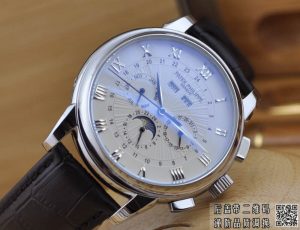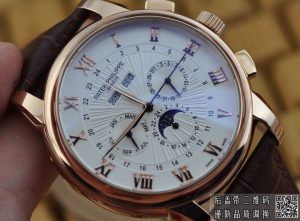Patek Philippe replica now provides the Aquanaut with a chronograph movement. The sporty, complex product is well suited to the company’s increasingly youthful and dynamic product line. But how does it work in real life?
The Patek Philippe Aquanaut was first appeared in 1997 and is one of the most popular collections at Patek Philippe, together with the Twenty-4 introduced in 1999. The CH 28-520 C caliber that powers the watch is almost 10 years younger still – the first chronograph movement for the Nautilus-inspired watch with its rounded octagonal bezel.
The Aquanaut Chronograph, our test watch, has an outstanding orange “Tropical” strap made of modern composite rubber that’s resistant to wear, saltwater, and UV rays, and is combined with a new double folding clasp. With four independent capture and two side buttons, its patented design offers extreme reliability and ease of operation. It has two spring strips at the end of the strap, so it has to adjust to the size of the wearer’s wrist — a powerful move that doesn’t allow for mistakes. And in the event of a distinguished occasion, Patek Philippe also delivers the Aquanaut Chronograph with an additional black strap. 
To increase wrist stability, the two ends of the strap are not only fixed by a traditional spring rod but also inserted into the case from one end of the strap by two pins. Therefore, Patek Philippe recommends having the strap changed by an authorized service person, which limits its ease of use.
But why change bands? We found that the orange band highlighted the color markings on the dial that showed the timing function; the long, slender chronograph hand that extends from the center of the dial; the minutes hand over the subdial at 6 o’clock; the markings of the 4-Hz chronograph track around the dial together with the elapsed-minutes track around the subdial. This adopts the same shape as the rounded octagon of the bezel.
Self-winding Caliber CH 28-520 C ensures a high level of accuracy, combining a classic column-wheel with modern vertical-disk clutch control. It is the only chronograph movement at Patek Philippe with this type of clutch. Its design keeps any forward or backward jumping of the stopwatch hand when the chronograph is engaged and it runs so smoothly that the centrally mounted chronograph hand can also be used as a permanent sweep seconds hand, which is why the Aquanaut Chronograph does not have a separate seconds hand. 
The date is also noteworthy. It advanced by less than a second in the middle of the night — so fast that the human eye could not detect it. It can be adjusted by pushing 8 points through a synthesis. Patek Philippe replica supplies a correction stylus made of ebony and white gold, but a crown-based function would be more convenient.
In the simulated wearing test – while the chronograph is engaged – the replica watch ran with virtually no deviations at all. When fully wound and with the chronograph running, the timing machine recorded an average daily rate of -0.4 seconds per day, and after 24 hours of running time, without additional winding, the rate was -0.7 seconds. These values are similar when there is no timing. The amplitude difference is about 10 degrees.
The fake watch mechanism is housed in a stainless-steel case that sports both polished and brushed finishes and is water-resistant to a depth of 120 meters. The crown guard gave it a slightly asymmetrical appearance. All tightening operating elements work normally. Manual winding and setting operations are very smooth. The broad, faceted timepiece is rolled out requiring solid pressure, due to the jaw, to hold and release the vertical clutch.

$27 Clone Rolex vs Genuine Rolex, Cheap Rolex Replica US
Fake Rolex For Men
